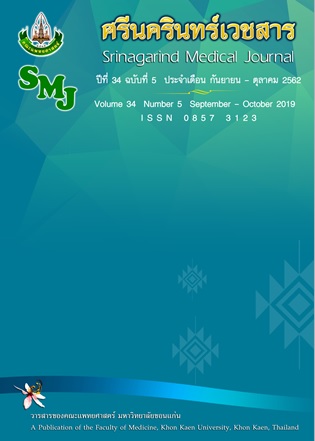Prevalence of Irritant Contact Dermatitis in Semiconductor Factory Workers Who Occupationally Wore Natural Rubber Finger Cots
Keywords:
irritant contact dermatitis, semiconductor factory workers, rubber additives, โรคผื่นระคายสัมผัส, พนักงานโรงงานผลิตชิ้นส่วนอิเล็กทรอนิกส์, สารเติมแต่งยางAbstract
ความชุกของพนักงานที่สวมถุงนิ้วยางธรรมชาติที่พบเป็นโรคผื่นระคายสัมผัสในโรงงานผลิตชิ้นส่วนอิเล็กทรอนิกส์
อัถสิทธ์ รัตนารักษ์1, เนสินี ไชยเอีย1*, จิตต์ลัดดา ศักดาภิพาณิชย์2, จินต์จุฑา วิริยะนันทวงศ์2, ภาณุมาศ ไกรสร1
1สาขาวิชาอาชีวเวชศาสตร์ ภาควิชาเวชศาสตร์ชุมชน คณะแพทยศาสตร์ มหาวิทยาลัยขอนแก่น
จ.ขอนแก่น
2ศูนย์ความเป็นเลิศด้านนวัตกรรมทางเคมี ภาควิชาเคมี คณะวิทยาศาสตร์ มหาวิทยาลัยมหิดล
หลักการและวัตถุประสงค์: พนักงานโรงงานผลิตชิ้นส่วนอิเล็กทรอนิกส์เป็นอาชีพที่ต้องมีการสัมผัสสารก่อระคายเคืองหลายชนิด เช่น ตัวทำละลาย กรด ด่าง และฟลักซ์ ทำให้มีความเสี่ยงสูงต่อการเกิดโรคผื่นระคายสัมผัส การศึกษานี้มีวัตถุประสงค์เพื่อศึกษาความชุกพนักงานที่สวม finger cots (ถุงนิ้วยางธรรมชาติ) ที่พบเป็นโรคผื่นระคายสัมผัสในในโรงงานผลิตชิ้นส่วนอิเล็กทรอนิกส์
วิธีการศึกษา: เป็นการศึกษาเชิงพรรณนา ประชากรศึกษา เป็นพนักงานผลิตชิ้นส่วนอิเล็กทรอนิกส์ของโรงงานแห่งหนึ่ง ที่สวม finger cots ขณะปฏิบัติงาน จำนวน 1,218 ราย มีขนาดตัวอย่าง 367 ราย ข้อมูลอาการทางผิวหนัง และปัจจัยต่างๆที่เกี่ยวข้องได้จากเวชระเบียนของพนักงานของห้องปฐมพยาบาล และจากการสอบสวนการระบาดของโรคผื่นระคายสัมผัส ร่วมกับการศึกษาชนิดของสารเติมแต่งยาง (rubber additives) ที่พบใน finger cots ด้วยเทคนิค High Performance Liquid Chromatography (HPLC) วิเคราะห์ด้วยสถิติเชิงพรรณนา นำเสนอด้วย สัดส่วน ค่าเฉลี่ย ค่ามัธยฐาน และช่วงเชื่อมั่นร้อยละ 95
ผลการศึกษา: พบความชุกของโรคผื่นระคายสัมผัสในพนักงานโรงงานผลิตชิ้นส่วนอิเล็กทรอนิกส์สวม finger cots ร้อยละ 11.4 (95% CI: 8.2,15.5) พนักงานในแผนกที่ใช้ finger cotsที่ซักล้างด้วยน้ำยาล้างจาน มีความชุกโรคผื่นระคายสัมผัสสูงที่สุดร้อยละ 15.3 ขณะที่แผนกที่ซักล้างfinger cotsด้วยสบู่เหลวพบ ร้อยละ 1.0 ผลการตรวจวิเคราะห์สารใน finger cots ที่ผ่านการซักล้างด้วยเทคนิค HPLC พบมี rubber additives 3 ชนิด ได้แก่ Tetramethylthiuram disulfide (TMTD), Zinc diethyldithiocarbamate (ZDEC) และ 2,2 Dibenzthiazyl disulfide (MBTS) โดยแผนกที่ซักล้างfinger cotsด้วยน้ำยาล้างจานพบสารดังกล่าวมากกว่า
สรุป: พบความชุกของพนักงานโรงงานผลิตชิ้นส่วนอิเล็กทรอนิกส์ที่สวม finger cots ที่พบเป็นโรคผื่นระคายสัมผัสในอยละ 11.4 ซึ่งการสัมผัส rubber additives อาจเป็นสาเหตุ
Background and Objective: The semiconductor factory workers who exposed to many irritants such as solvents, acids, alkalis and flux was the high risk of occupational irritant contact dermatitis. This study aimed to estimate the prevalence of the semiconductor factory workers who occupationally wore natural rubber finger cots.irritant contact dermatitis (ICD) in
Methods: A descriptive study was conducted. The study population included 1,218 workers who occupationally wore natural rubber finger cots. A total of 367 workers were recruited as study samples. The skin symptoms and the associated factors were collected from the medical records and the existing completed questionnaires. Additives containing in finger cots were analyzed by HPLC (High Performance Liquid Chromatography) technique. The descriptive statistics were presented as proportion, mean (SD), median (IQR) and the prevalence were presented as percentage with 95% confidence interval (95%CI).
Results: The prevalence of irritant contact dermatitis in semiconductor factory workers was 11.4% (95%CI 8.2,15.5) 15.3% of workers who wore natural rubber finger cots which were always washed by dish washing liquid was diagnosed ICD compared to 1 (1.0%) worker who wore natural rubber finger cots which were always washed by hand washing soap. The finger cots analysis by HPLC found 3 leachable rubber additives such as Tetramethylthiuram disulfide (TMTD), Zinc diethyldithiocarbamate (ZDEC) and 2,2 Dibenzthiazyl disulfide (MBTS) from finger cots washed by either hand soap and dish washing liquid, but higher in dish washing liquid washed finger cots.
Conclusion : The prevalence of irritant contact dermatitis in semiconductor factory workers who occupationally wore natural rubber finger cots was 11.4% . The possible agents were rubber additives.
References
Salako KB, Chowdhury MMU. Occupational skin disorder. In: Ladou J, Harrison RJ, editors. Current occupational and environmental medicine. 5thed. U.S.A.: McGraw-Hill; 2007.
Higgins CL, Palmer AM, Cahill JL, Nixon RL. Occupational skin disease among Australian healthcare workers: a retrospective analysis from an occupational dermatology clinic, 1993-2014. Contact Dermatitis 2016 ; 75: 213–22.
Cahill JL, Williams JD, Matheson MC, Palmer AM, Burgess JA, Dharmage SC, et al. Occupational skin disease in Victoria, Australia. Australas J Dermatol 2016; 57: 108–14.
Coman G, Zinsmeister C, Norris P. Occupational contact dermatitis: workers’ compensation patch test results of Portland, Oregon, 2005-2014. Dermat Contact Atopic Occup Drug 2015; 26: 276–83.
แสงโฉม ศิริพานิช. การพัฒนาระบบเฝ้าระวังโรคจากการประกอบอาชีพและสิ่งแวดล้อมแบบเชิงรับ. กรุงเทพฯ: สำนักระบาดวิทยา; 2558.
Warshaw EM, Hagen SL, DeKoven JG, Zug KA, Sasseville D, Belsito DV, et al. Occupational contact dermatitis in North American production workers referred for patch testing: retrospective analysis of cross-sectional data from the North American contact dermatitis group 1998 to 2014. Dermat Contact Atopic Occup Drug 2017; 28: 183–94.
Chew AI, Maibach HI. Occupational issues of irritant contact dermatitis. In: Chew AI, Maibach HI, editors. Irritant dermatitis. Berlin Heidelberg: Springer-Verlag; 2006. p. 113-22.
Koh D, Foulds IS, AwTC. Dermatological hazards in the electronics industry. Contact Dermatitis 1990; 22: 1-7
Williams ME. Microelectronics and semiconductors. In: Stellman JM, editor. Encyclopaedia of occupational health and safety. Vol.3. 4thed. Geneva: International labour office; 1998.
Centers for disease control and prevention. Contact dermatitis and latex allergy [Online] 2013 [cited Mar 22, 2019]. Available from: https://bit.ly/2w59Vbv
Shiao JSC, Sheu HM, Chen CJ, Tsai PJ, Guo YL. Prevalence and risk factors of occupational hand dermatoses in electronics workers. Toxicol Ind Health 2004; 20: 1-7.
Malik M, English J. Irritant hand dermatitis in health care workers. Occup Med Oxf Engl 2015; 65: 474-6.
รัญญา บุญชัย, กัณห์ชลิต ถนอมกิตติ, ปราณี เกษมศานติ์. การศึกษาด้านระบาดวิทยาย้อนหลัง 5 ปีของผู้ป่วยโรคผื่นสัมผัสที่เกิดจากการทำงานในโรงพยาบาลมหาวิทยาลัยระดับตติยภูมิ 2557; 99: 1182-8.
Carøe TK, Ebbehøj NE, Agner T. Occupational dermatitis in hairdressers-influence of individual and environmental factors. Contact Dermatitis 2017; 76: 146-50.
Behroozy A, Keegel TG. Wet-work exposure: a main risk factor for occupational hand dermatitis. Saf Health Work 2014; 5: 175–80.
Mirza R, Maani N, Liu C, Kim J, Rehmus W. A randomized, controlled, double-blind study of the effect of wearing coated pH 5.5 latex gloves compared with standard powder-free latex gloves on skin pH, transepidermal water loss and skin irritation. Contact Dermatitis 2006; 55: 20–5.
Human and environmental risk assessment on ingredients of household cleaning products. Linear alkylbenzene sulphonate [Online] 2013[cited Jun 23, 2018]. https://bit.ly/2SuAVfO.
Leibert MA. Final report on the safety assessment of sodium laureth sulfate and ammonium laureth sulfate. J Am Coll Toxicol 1983; 2:1-34.
สุวภา ชำนาญการ. ปัจจัยที่มีผลต่อการเคลื่อนย้ายออกมาของสารเตตระเมธิลไทยูแรมไดซัลไฟด์และสารกลุ่มไดไทโอคาร์บาเมตจากถุงมือยางที่ใช้สัมผัสอาหาร. สงขลา: มหาวิทยาลัยสงขลานครินทร์; 2556.
Charney W. Handbook of modern hospital safety. 2ndEd. Florida: Taylor&Francis Group; 2009.
Salminen WF, Roberts SM. Dermal and ocular toxicity:toxic effect of the skin and eyes. In: Williams PL, James RC, Roberts SM, editors. Principles of toxicology environmental and industrial applications. 2nd ed. U.S.A.: John Wiley & Sons; 2000:157-68.
Kasemsarn P, Bosco J, Nixon RL. The role of the skin barrier in occupational skin diseases. Curr Probl Dermatol 2016; 49: 135–43.
Amado A, Sood A, Taylor JS. Irritant contact dermatitis. In: Goldsmith LA, Katz SI, Gilchrest BA, Paller AS, Leffell DJ, Wolff K. Fitzpatrick's dermatology in general medicine. 8th ed. New York: McGraw-Hill; 2012.


